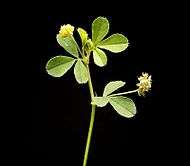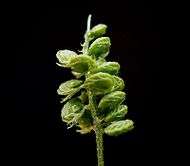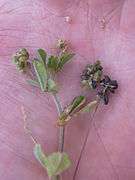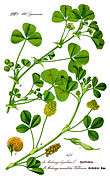Medicago lupulina
| Medicago lupulina | |
|---|---|
 | |
| Scientific classification | |
| Kingdom: | Plantae |
| (unranked): | Angiosperms |
| (unranked): | Eudicots |
| (unranked): | Rosids |
| Order: | Fabales |
| Family: | Fabaceae |
| Subfamily: | Faboideae |
| Tribe: | Trifolieae |
| Genus: | Medicago |
| Species: | M. lupulina |
| Binomial name | |
| Medicago lupulina L. | |
Medicago lupulina, commonly known as black medick, nonesuch, or hop clover, is a familiar lawn plant belonging to the legume or clover family. Plants of the genus Medicago, or bur clovers, are closely related to the true clovers (Trifolium) and sweet clover (Melilotus). Like the true clovers, black medick has three leaflets and a small, yellow flower closely resembling those of the lesser trefoil. Black medick belongs to the same genus as alfalfa.[1]
Names
The generic name, Medicago, is derived from the Greek medike (Latin medica), because alfalfa was believed to have been introduced from Medea in antiquity. The specific name, lupulina, means "wolf-like," and refers to the hop, or willow-wolf (Humulus lupulus). Its scientific name is a translation of the common name, "hop clover" (or "hop-clover"), which is also used for several members of the genus Trifolium.[2][3]
Also spelled medic or meddick, the plant is known by a number of alternate names, including nonesuch, black nonesuch, black medic clover, hop clover, hop medic, black clover, black hay, blackweed, English trefoil, hop trefoil, and yellow trefoil. Some of these names are also applied to wildflowers of the related genera Trifolium and Melilotus.[4][5][6][7]
Description
Medicago lupulina is an annual or short-lived perennial plant,[8]:168 growing each year from adventitious buds on the roots. Mature plants measure from fifteen to eighty centimeters (32 inches) in height, with fine stems often lying flat at the beginning of growth and later erecting. The leaves are compound, each with three oval leaflets, carried on a short petiole; the center leaflet usually has a longer petiole.[9][2] The leaflets are hairy, toothed toward the tip, and differ from those of the similar Trifolium dubium in that they end in a short point.[10]:148[8]:175
Black medick has small yellow flowers, often grouped in tight bunches, and typically measuring between two and four millimeters in diameter; but on larger plants the flowers may reach eight millimeters or more (1/3 inch).[2]
The fruit is a small, ovoid pod, between one and two millimeters in length, that does not open upon maturation, but hardens and turns black when ripe. Each pod contains a single amber-colored seed.[9]
Like other legumes, the roots of black medick contain nodules hosting nitrogen-fixing bacteria. Plants that survive for more than one year may develop a deep tap root.[9]
Distribution
A native of the old world, black medick is found throughout Europe, north Africa, the near east, and most of Asia, including India, China, and Korea. It is naturalized in central Asia, Japan, South Africa, Australia, New Zealand, the United States, Canada, and much of South America.[4] Black medick is found throughout the United States, including Hawaii and Alaska.[5]
Black medick thrives in dry to moist, well-drained soils containing sand, loam, or clay, and is a pioneer plant, often growing on disturbed ground. It grows in alkaline, neutral, and mildly acidic conditions. It does not grow in shady areas.[11] Black medick grows well in limestone soils and on coastal sand dunes, where it suffers less competition from the other plants, and as such is found on many islands, such as Taiwan, the Canary Islands, the Azores, and Madeira.[4] It is resistant to cold,[9] and can be found on mountains up to 1,800 meters.
Uses
A common sight in dry or well-drained lawns, where it may be considered a weed, black medick is one of the flowers used to make honey. It is frequently found in natural pastures, and may be planted in order to create artificial meadows, especially on dry land. The presence of black medick in large concentrations in a lawn may indicate that the soil is poor in nitrogen. However, because black medick and other clovers fix nitrogen in the soil, this deficiency can improve over time due to the presence of these plants.[4][12]
Black medick is sometimes used as a fodder plant. Its hardiness and ability to grow in poor soils, as well as its tendency to fix nitrogen in the soil, make black medick a good choice for pasturage, although its fodder value is limited.[4][9]
Similar plants
Black medick may be confused with other plants that have three leaflets and small yellow flowers, such as hop trefoil, large hop trefoil, lesser hop trefoil, and yellow woodsorrel.
Photographs
 Flower
Flower Leaves and flowers
Leaves and flowers Flowers wilting after pollination
Flowers wilting after pollination unripe seed pods (green)
unripe seed pods (green) ripe seed pods (black)
ripe seed pods (black)- seeds
- Root with nodules
 an entire uprooted plant
an entire uprooted plant
Illustrations
References
- ↑ Frank D. Venning, Wildflowers of North America (Golden Field Guide), St. Martin's Press, 1984.
- 1 2 3 Wisconsin State Herbarium, Flora of Wisconsin, "Medicago lupulina," wisflora.herbarium.wisc.edu, retrieved 14 June 2015.
- ↑ University of Wisconsin–Stevens Point, Plants of Wisconsin database, "Medicago lupulina," <http://wisplants.uwsp.edu>, retrieved 14 June 2015. This database is scheduled to go off-line on July 13, 2015, due to its merger with the Wisconsin State Herbarium database; the latter does not explain the specific name.
- 1 2 3 4 5 United States Department of Agriculture Germplasm Resources Information Network (GRIN), "Medicago Lupulina," www.ars-grin.gov, retrieved 14 June 2015.
- 1 2 Integrated Taxonomic Information System (ITIS), "Medicago lupulina," ITIS Report, retrieved 14 June 2015.
- ↑ https://books.google.com/books?id=nVUJAAAAQAAJ&lpg=PA355&ots=ldcA58j8ev&dq=%22Black%20Nonsuch%22&pg=PA355#v=onepage&q=%22Black%20Nonsuch%22&f=false
- ↑ http://www.arthurleej.com/a-blackmedick.html
- 1 2 Stace, C.A. (2010). New flora of the British isles (Third ed.). Cambridge, U.K.: Cambridge University Press. ISBN 9780521707725.
- 1 2 3 4 5 Oregon State University Forages database, "Black Medic," forages.oregonstate.edu, retrieved 14 June 2015.
- ↑ Blamey, M.; Fitter, R.; Fitter, A (2003). Wild flowers of Britain and Ireland: The Complete Guide to the British and Irish Flora. London: A & C Black. ISBN 978-1408179505.
- ↑ Plants for a Future (PFAF), "Medicago lupulina," www.pfaf.org, retrieved 14 June 2015.
- ↑ Andy Clark (editor), Managing Cover Crops Profitably, 3rd ed. "Medics", retrieved 14 June 2015.
External links
- Entry in the Linnean herbarium
- A mention in 1866 from the Correspondence of Charles Darwin: "Several years ago I protected Medicago lupulina from insects, & its fertility was much impaired, but not wholly prevented."
- WeedAlert.com's listing for Medicago lupulina
- Effect of Black Medic Cover Crop on N Supplying Power of Prairie Soils
- Wikispecies entry
| Wikimedia Commons has media related to Medicago lupulina. |



